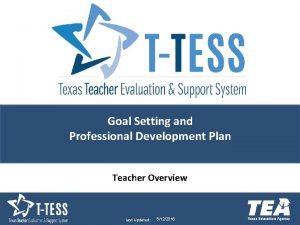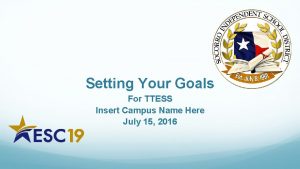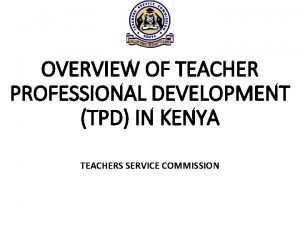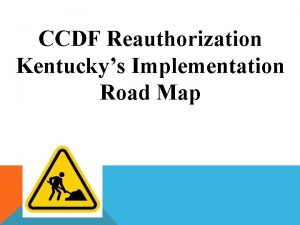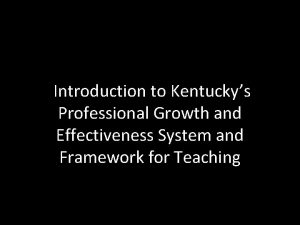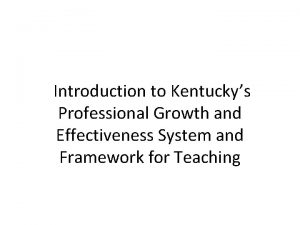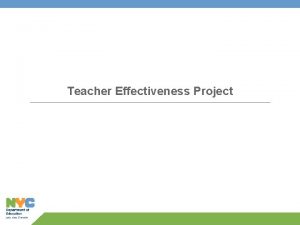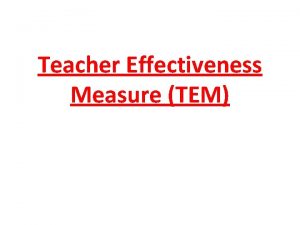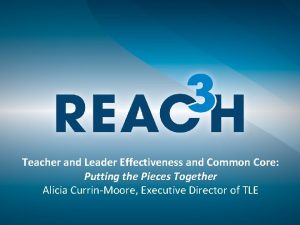IMPROVING TEACHER LEADER EFFECTIVENESS PROGRESS ON KENTUCKYS PROFESSIONAL















- Slides: 15

IMPROVING TEACHER & LEADER EFFECTIVENESS: PROGRESS ON KENTUCKY’S PROFESSIONAL GROWTH AND EVALUATION SYSTEM JUNE 20, 2011 CCSSO National Conference on Student Assessment

Background Last year, Commissioner Holliday presented to the IJCE KDE’s plans to develop a new teacher and leader professional growth and evaluation system to improve the effectiveness of KY teachers. Such a system was required for KY’s Race To the Top application and would enable KDE to provide other federally-mandated data. Because of its importance, Commissioner Holliday decided to continue the work with limited available funding.

Charge of the Steering Committees To provide guidance on the design, development and deployment of the Teacher and Principal Professional Growth and Evaluation systems.

Characteristics of the New System Moves the discussion from teacher quality (as measured by degrees/rank) to teacher & leader effectiveness (are students learning? ) Focuses on teacher and principal professional growth; is fair and equitable to those being evaluated Developed through a collaborative, inclusive and transparent process Comprehensive/holistic approach incorporating multiple measures.

What are the Multiple Measures? Teacher Effectiveness Rubric Observation Protocols/ Val. Ed 360 Artifacts & Evidence Professional Growth Student Growth Principal Effectiveness Rubric Student Growth Analysis & Reflection School Goals Student/Parent Voices

What progress has been made to date? We are on target with the timelines for our work. Teacher and Principal Effectiveness Steering Committee(s) representing KASA, KSBA, KEA, JCTA, CPE, colleges and universities, EPSB, parents, and individual teachers, principals and superintendents from volunteer districts have been convened and met quarterly over the past year. To identify the characteristics of good teaching and leadership practice, the committees and volunteer districts were provided with previously developed rubrics of teacher/leader effectiveness as a beginning point for discussion (teacher rubric – KDE work with Wallace Foundation, principal rubric – designed by a subgroup of

What progress has been made to date? Through a focus group process, the volunteer districts recommended changes to the initial and subsequent rubrics over the course of the year. A design team of KDE, KLA*, and Education Partners incorporated those changes to create revised version(s) of the rubric. The recommended changes were submitted to the steering committees on three separate occasions for review and additional recommendations, using a focus group cycle to receive input. Approximately 25 school districts were involved in the design and development of the current rubrics, which reflect the collaborative work of local districts and our steering committees. *A professional development initiative within the Kentucky Association of School Administrators (KASA).

Progress to Date: Implementation Cycle Steering Committee (Provides initial guidance) Design Team (Incorporates Focus Group guidance into documents) (incorporates Committee guidance into documents) Regional Focus Group (Reviews total components) District Focus Group (Reviews individual components) The feedback loop provided local districts and steering committee members the opportunity to inform the work at each stage of the process.

Progress to Date: Guidance from Experts Dr. James Stronge, a nationally-recognized expert in teacher effectiveness, conducted a two-day workshop in April with the teacher steering committee and volunteer districts, provided expert review of the rubric and recommended next steps in the development process. Experts on the Val-Ed* 360 degree component of the principal rubric are scheduled to be brought in to work with the principal effectiveness steering committee and volunteer districts. Input from experts will continue to inform the work throughout the development and implementation phases.

Timelines for Deployment of the New System Phase 1 (20112012) Field Test • Participating districts identified (up to 50) • Districts trained in field test protocols • Districts implement field test protocols • Districts participate in regional field test status meetings Phase 2 (20122013) Pilot • Additional participating districts identified (40 -50) • Districts trained in pilot protocols • Districts implement pilot protocols • Districts participate in regional pilot status meetings Phase 3 (2013) Implementation • State-wide training • State-wide implementation

Next Steps: Development Work Multiple steering committee and volunteer district meetings are being scheduled for the upcoming year. Revisions to the rubric will continue based on data gleaned from initial focus group and steering committee work. Plans are being discussed for large-scale field-testing that will occur during the 2011 -2012 school year - the committees will be discussing field-test goals, purpose, roles, expectations; communication and feedback structure; participant selection; timelines; training modules; deliverables and resources needed. Communication of the status of the work to interested parties through presentations to organizations will continue. (KASA, NMSA, KAAC, KSBA, OVEC, KEDC, CKEC, to name a few)

Next Steps: State Consortium on Educator Effectiveness (SCEE) Kentucky is one of the states invited by the Council of Chief State School Officers (CCSSO) to participate in the State Consortium on Educator Effectiveness (SCEE). SCEE participants collaborate virtually to study/share policies and practices to improve the effectiveness of the nation's educators. On April 28 -20, 2011, SCEE hosted a National Summit on Educator Effectiveness, allowing participating members to meet, network and share promising practices related to teacher effectiveness. Kentucky’s seven-person team included Rep. Carl Rollins (State Legislature); Brenda Mc. Gown (KEA); Phillip Rogers and Robert Brown (EPSB); Larry Stinson, Michael Dailey, and Donna Brockman (KDE).

Link to Webpages Http: //kyprofessionalgrowth. webs. com/documents. h tm

TELL KY Survey Results TELL Kentucky was a tremendous success! • • 42, 025 (80%) educators responded to the TELL Kentucky Survey ! No other state has every achieved an 80% response rate in a first year implementation. 1245 schools, out of 1395, met or exceeded the 50% response rate necessary for data to be available! 128 districts had every school in their district reach the minimum threshold for response rate 1800 administrators responded to the survey (1057 principals, 743 assistant principals) !

TELL KY Survey Results by district are available at: http: //www. tellkentucky. org/reports/
 Stronge leader effectiveness performance evaluation model
Stronge leader effectiveness performance evaluation model Physical progress and financial progress
Physical progress and financial progress Improving student learning one teacher at a time
Improving student learning one teacher at a time Improving student learning one teacher at a time
Improving student learning one teacher at a time Transactional vs transformational leadership
Transactional vs transformational leadership Teacher leader endorsement illinois
Teacher leader endorsement illinois How to write a proper email to your teacher
How to write a proper email to your teacher Gspd goals
Gspd goals Good ttess goals
Good ttess goals Conclusion of unesco
Conclusion of unesco Teacher professional development plan examples
Teacher professional development plan examples Domain 6 community linkages reflection
Domain 6 community linkages reflection Teacher professional development in kenya
Teacher professional development in kenya The teacher and higher authorities in the philippines
The teacher and higher authorities in the philippines How do you greet your teacher in the afternoon
How do you greet your teacher in the afternoon Erf requirements
Erf requirements







